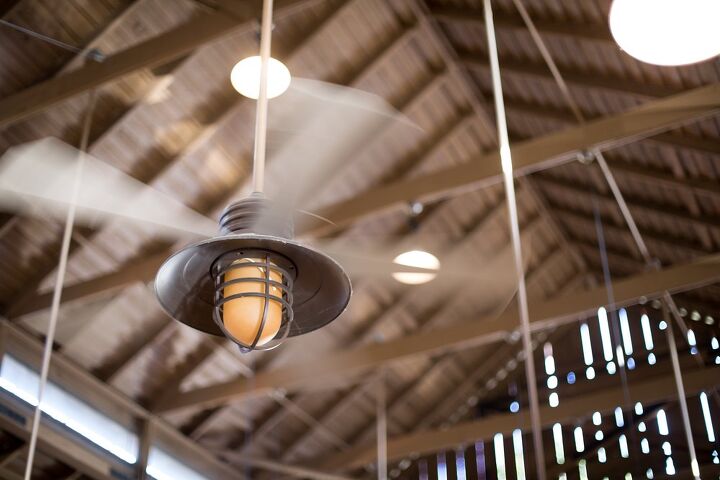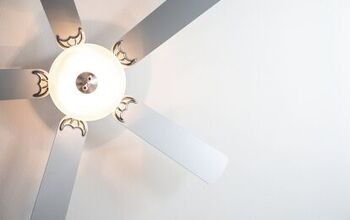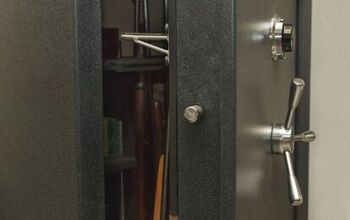Can You Put A Ceiling Fan In The Garage? (Find Out Now!)

No longer just for parking vehicles, garages have become workspaces and storage areas that we use on a daily basis. It is where many homeowners have their laundry rooms, sporting equipment, and more. Because your HVAC system doesn’t extend into the garage, it gets very warm, and a ceiling fan helps.
You can install a ceiling fan in your garage. Use a fan with a UL rating for damp or wet conditions. Mount the fan in the center of the roof with clearance for vehicles, garage door rails, and people. Buy a fan that produces enough air flow to cool the space.
Let’s look at the pros and cons of a ceiling fan in the garage, as well as the best way to install one in the space.
Do You Need Ceiling Fan Installers?
Get free, zero-commitment quotes from pro contractors near you.

Pros of a Ceiling Fan in the Garage
A ceiling fan in your garage cools the space by creating air flow. A secondary benefit that most homeowners don’t know about is that it will reduce your energy costs. Heat loss is a major contributor to high energy bills each month. The garage is one of the areas that adds to heat loss anytime of year. Installing a ceiling fan saves you up to 40% on your utility bills.
Cons of a Ceiling Fan in the Garage
The cons of installing a ceiling fan in your garage have to do with space loss near the ceiling. You’ll have to consider the position of the rails for your garage door. Additionally, you may not be able to park taller vehicles in the garage after you install the ceiling fan. Overhead storage is also reduced because you need room for the fan assembly and rotating blades.
Where Should a Ceiling Fan Be Placed in a Garage?
The best place for a ceiling fan in the garage is in the center of the ceiling. This moves the warm air from the upper part of the garage downward. Ideally, keep the garage door or windows open to give the warm air a place to exit the space.
Air flow from a ceiling fan in the garage also creates a cooling effect. As air moves over your skin, it evaporates sweat faster. This helps your body release heat faster, and you feel cool.
What Type of Ceiling Fan Works Best in a Garage?
Garage ceiling fans are exposed to the elements; therefore, you need to check the specs for the model that you are considering. Check the specifications for the model, including:
- UL rating
- Fan size
- Lighting
- Air flow rating
- Number of blades
UL Rating for Garage Ceiling Fans
The UL rating for a ceiling fan indicates if the fan can be used indoors and outdoors. Look for a ceiling fan that is rated for damp and wet conditions.
Fan Size
Fan size includes the blade length and the total diameter of the ceiling fan. Also check the height of the ceiling fan motor housing. Compare this with the height of your garage at the center or where you are installing the fan. Make sure there is enough clearance under the fan for people and vehicles.
Lighting
Ceiling fans are great for adding light to a garage. Choose from a single center light or adjustable spotlights that can be set to illuminate specific work areas.
Air Flow Rating
Air flow rating of a ceiling fan for your garage makes a huge difference in how well it cools the space. Most ceiling fans are rated at 4,000 to 5,000 cubic feet per minute (CFM). You can find ceiling fans that are rated higher at 5,000 to 6,000 CFM. The best ceiling fans for garages are 6,000 CFM or higher.
Number of Blades
The number of blades on a garage ceiling fan is mostly about aesthetics, but there are some practical benefits. Garage ceiling fans that have more blades tend to be quieter, but the fan also circulates less air. A higher number of blades creates drag inside the motor, so less air flow is created by the energy output.
How Big of a Ceiling Fan Do I Need for a Garage?
The best size ceiling fan for your garage depends on the square footage.
- 44” to 50” ceiling fans work for 114 sq ft to 225 sq ft
- 50” or larger ceiling fans work for 225 sq ft to 400 sq ft
- 62” or larger ceiling fans work for more than 400 sq ft
How to Install a Ceiling Fan in a Garage
There are three ways to install a ceiling fan in a garage based on the construction of the space.
- Install the ceiling fan between the joists with a hanger and box
- Use a “pancake” box that is rated for ceiling fans and attach it to the joist
Electrical Wiring for a Garage Ceiling Fan
You’ll need electricity to run your garage ceiling fan. If the wiring doesn’t exist, install a new electrical box for two switches. One switch is for the fan, and the second is for the light. Even if you don’t have a light in your garage ceiling fan, it’s a good idea to pre-wire the switch.
Other Ways to Cool Your Garage
If a garage ceiling fan isn’t right for you, there are other ways to cool the space. Wall-mounted and floor fans work very well. For a garage with one or more windows, install a window AC unit. A portable swamp cooler also keeps the space comfortable. For climates with high humidity, use a dehumidifier. Reducing the moisture in the air creates a cooling effect. Insulate the walls and ceiling and add attic vents to keep the garage nice and comfortable throughout the year.
Related Questions
What is a flush mount garage ceiling fan?
Flush-mounted ceiling fans mount directly to the ceiling. Other types of ceiling fans have extension rods or other attachments.
Can you install a ceiling fan without going into the attic?
Yes. Use an existing circuit or run wiring to the electrical box.
Do You Need Ceiling Fan Installers?
Get free, zero-commitment quotes from pro contractors near you.

Conclusion
You can install a ceiling fan in your garage to save money on utility costs and keep your workspace cool. Choose the right type of ceiling fan, and mount it in the center of the garage. Make sure that there is enough clearance for vehicles and people.

Jennifer L. Eggerton loves being hands-on, whether it's with a home DIY project, making repairs, re-decorating a room, or keeping life organized. She enjoys helping people by sharing her knowledge, insights, and experiences, as well as her lessons learned. In addition to her work as a writer, Jennifer is a Jeep® overlander, self-published author, and nature photographer who loves being outdoors.
More by Jennifer Eggerton



























![10 Most Dangerous Neighborhoods in Baltimore [Updated]](https://cdn-fastly.upgradedhome.com/media/2023/07/31/9075655/10-most-dangerous-neighborhoods-in-baltimore-updated.jpg?size=350x220)